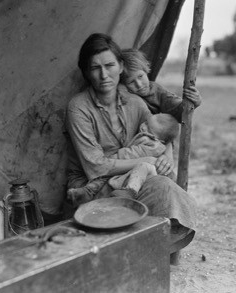
Soup kitchen
Lining up for free food during the Great Depression.
Photo Credit: National Archives at College Park / Public domain
During the Great Depression soup kitchens opened across America to feed the hungry. People waited in “breadlines” that stretched for blocks. Some eighty years later, Americans are lining up for miles for free food. Food banks are overwhelmed by the demand.
The Great Depression affected nearly 60 million Americans–about half the population. Unemployment reached nearly 25 percent. A half million workers were jobless in Chicago, and nearly a million in New York City, where charities and churches served up some 85,000 daily to those in need.
Eighty-two percent of farm families were classified as “impoverished.” One who endured the Great Depression in West Virginia recalled when a teacher told an inattentive student to go home and get some food. “I can’t,” the child replied. “It’s my sister’s turn to eat.”

Migrant agricultural worker’s family, 1936
Nipomo, California
Photo Credit: Photo by Dorothy Lange Courtesy, Library of Congress Prints and Photographs Division
In “the land of plenty,” federal efforts to help those in need were extremely limited. Some families made do growing fruit and vegetables in their backyards. They also canned. They cooked with whatever ingredients were on hand. That might be peanut butter stuffed onions, a dandelion salad or “Hoover Stew,” a concoction of macaroni, canned tomatoes, hot dogs, canned corn and beans. For dessert—for those who could afford the luxury—there was vinegar pie, or mock apple pie—made with crushed Ritz crackers but no apples. There was even water pie.
When the pandemic arrived last year, online searches for Great Depression recipes spiked. (Many can be found on YouTube). Even before the pandemic struck, roughly 37 million people in the U.S. lacked consistent, predictable access to foods required for a healthy lifestyle. That number has risen to 54 million today. Twenty million are kids.
The nonprofit Feeding America reports that its food banks have seen an 83 percent increase in people in need of food assistance since the pandemic began.

Food insecurity, 2020
Thousands line up at food banks across America.
Photo Credit: feedthevalley.org
Last year, visits to food banks nationwide increased by more than 50 percent, according to a CNN report.
In response to hunger brought on by the Great Depression, President Franklin Roosevelt called for the formation of the Federal Surplus Relief Corporation. Established in 1933, the New Deal agency directed agricultural commodities from the open market—where prices were depressed by surplus farm products—to needy families.
One distributor described his first delivery of surplus salt pork to a down-and-out community: “Finally I sez it was a present from the government. A lot of ‘em – especially the old folks – broke down and cried. I guess all some of ‘em had to eat is potatoes and beans and bread, and not too much of any of that. Some said they hadn’t tasted meat for months.”
Between 1933 and 1935, the Federal Surplus Relief Corporation, later renamed the Federal Emergency Relief Administration (FERA), sent millions of tons of government food to every state in the nation. Michigan alone received 15 million pounds of pork, butter, potatoes, eggs, lard, breakfast cereal, beans, cheese and other food products.

Eat These Every Day, circa 1942
Federal Art Project, NYC WPA War Services.
Photo Credit: Courtesy, Library of Congress
The federal government has stepped up food programs that began with New Deal. FERA today is the Emergency Food Assistance Program, part of the United States Food and Drug Administration (USDA). It provides the Special Supplemental Nutrition Program for Women, Infants and Children (WIC) and the Supplemental Nutrition Assistance Program (SNAP), formerly known as “food stamps.” In 2019, before the pandemic, 38 million Americans—1 in 9—qualified for SNAP; 42 percent of these were working families unable to make ends meet.
Despite recently expanded government assistance such as extended unemployment benefits and stimulus checks, an estimated 30 million U.S. households face food insecurity. With a battered economy and worsening income inequality, America must do more to keep struggling families fed, housed and healthy…far more than salt pork, bologna casseroles and a plate of hobo beans.